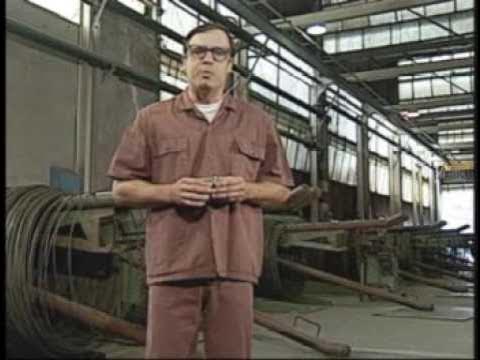FarewellEtaoinShrdlu
Summary
TLDRThe video captures the final moments of traditional hot metal printing at The New York Times, highlighting the transition from the century-old linotype machine to modern computerized cold type technology. It chronicles the intricate processes involved in creating a newspaper, from setting type with molten lead to the precise assembly of pages. The narrative follows printers adapting to new technology while reflecting on the end of an era, showcasing both nostalgia for the past and the inevitability of progress. The story underscores the importance of human skill amidst advancing automation.
Takeaways
- 🖨️ The video marks the end of an era for the Linotype machine, which used molten lead to cast lines of type for newspaper printing.
- 📅 July 2, 1978, is a significant date as it marks the last day of traditional hot metal printing in the composing room of The New York Times.
- 🛠️ The Linotype machine was invented by Ottmar Mergenthaler over 100 years ago and revolutionized mass printing by lowering the cost of books and making education more accessible.
- 🔡 In the composing room, printers prepared columns of text by manually assembling brass molds of letters to be cast in molten lead.
- 💻 A new era of computerized, electronic, and cold type technology is replacing the traditional method, marking a significant shift in newspaper production.
- ⚙️ The linotype machine functioned with precision, resembling a large clock with its mechanical operations, running like a well-tuned machine.
- 👴 The transition from old to new technology is emotional for veteran workers, who express a sense of loss for the old methods that are being replaced by automation.
- 🕰️ Workers on the linotype machine manually set type letter by letter, a process that echoed the methods used by Gutenberg over five centuries ago.
- 🔍 The new cold type technology allows for faster and more efficient printing, increasing productivity from 14 lines per minute to 1,000 lines per minute.
- 📈 Despite the advances in automation and computerized processes, the video emphasizes that the human brain, eyes, and hands remain critical in the printing process.
Q & A
What is the main focus of the video transcript?
-The video transcript focuses on the final moments of the linotype printing process at The New York Times, marking the transition from the traditional hot type printing method to computerized cold type photo technology.
What date marks the end of the linotype printing era at The New York Times?
-The transition occurred on Sunday, July 2nd, 1978, marking the end of the linotype printing era at The New York Times.
What was the significance of the linotype machine in printing history?
-The linotype machine, invented by Ottmar Mergenthaler, revolutionized printing by enabling the mass production of printed material, making books and newspapers more affordable and accessible, contributing to mass education.
How does the linotype machine work?
-The linotype machine assembles brass matrices of letters in a composing stick, which are then cast into solid slugs of type using molten lead. The line of type is then cooled, trimmed, and used in the printing process.
What role does the 'makeup man' play in the printing process?
-The 'makeup man' is responsible for assembling the newspaper page by positioning lines of type and picture cuts into full-page forms, guided by the editor's layout sheets.
What technological advancements replaced the linotype machine?
-The linotype machine was replaced by computerized electronic cold type photo technology, which used photo-sensitive paper and laser scanning to create plates for printing, greatly increasing the speed and efficiency of the process.
What is the significance of the term 'hot type' and 'cold type'?
-'Hot type' refers to the traditional printing method where molten lead was used to create lines of type, while 'cold type' refers to the newer, computerized method that involves photo-sensitive paper and electronic type generation without the use of molten metal.
How did the workers feel about the transition to computerized printing?
-Many workers expressed sadness and nostalgia about the end of the linotype era, with some feeling that their years of experience and skill were becoming obsolete. However, they acknowledged the inevitability and benefits of the technological advancements.
What was the purpose of the proofing process in the printing room?
-The proofing process involved creating a galley proof to check for errors in the typeset text. Any mistakes were corrected before the final page was locked up and sent to the presses.
How did the new computerized system improve productivity in the printing process?
-The new computerized system increased productivity by allowing type to be generated at 1,000 lines per minute, compared to the 14 lines per minute produced by the linotype machines. This automation also allowed for quicker adjustments and corrections.
Outlines

هذا القسم متوفر فقط للمشتركين. يرجى الترقية للوصول إلى هذه الميزة.
قم بالترقية الآنMindmap

هذا القسم متوفر فقط للمشتركين. يرجى الترقية للوصول إلى هذه الميزة.
قم بالترقية الآنKeywords

هذا القسم متوفر فقط للمشتركين. يرجى الترقية للوصول إلى هذه الميزة.
قم بالترقية الآنHighlights

هذا القسم متوفر فقط للمشتركين. يرجى الترقية للوصول إلى هذه الميزة.
قم بالترقية الآنTranscripts

هذا القسم متوفر فقط للمشتركين. يرجى الترقية للوصول إلى هذه الميزة.
قم بالترقية الآنتصفح المزيد من مقاطع الفيديو ذات الصلة
5.0 / 5 (0 votes)






